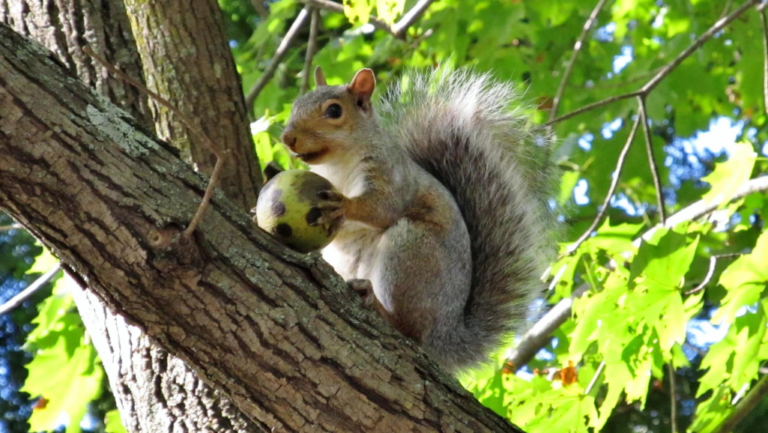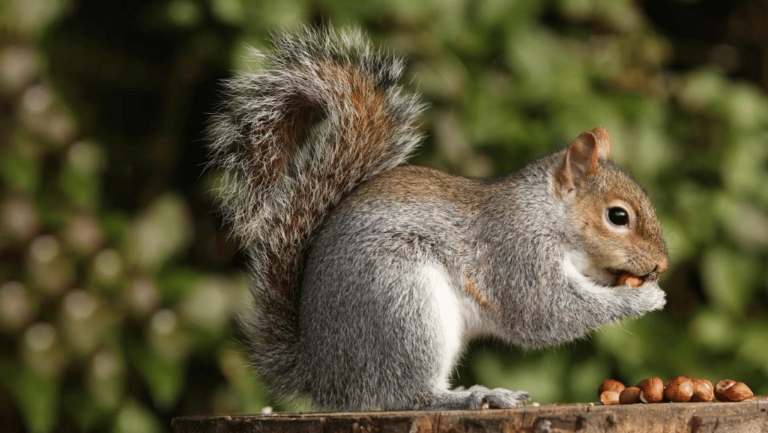Protecting your property from the damaging effects of urban squirrels is essential for maintaining its integrity and aesthetics. Whether you’re dealing with ground squirrels or grey squirrels, effective pest management solutions are key to mitigating the potential destruction they can cause.
Key Takeaways:
- Urban squirrel management is crucial for safeguarding your property from damage.
- Understanding the behavior and life cycles of squirrels is essential for effective management.
- Professional pest control services can provide expert solutions for squirrel management.
- Habitat modification, trapping, and exclusion are effective techniques for ground squirrel control.
- Preventive measures, such as sealing entry points, can help prevent grey squirrel infestations in buildings.
Identifying and Understanding Ground Squirrels
The California ground squirrel, a common species found in and around homes and gardens in California, possesses distinctive features that enable easy identification. With their mottled brown fur and bushy tails, these squirrels stand out among other species. Their appearance is characterized by a blend of colors, which helps them camouflage in their natural habitat.
Ground squirrels exhibit specific behaviors and preferences when it comes to feeding. As herbivores, they consume primarily plants and vegetation. However, their feeding habits may vary depending on the season. During the summer months, ground squirrels tend to feed on grasses, seeds, and green vegetation. In the fall, their diet shifts towards a preference for acorns and other nuts as they stockpile food for the winter.
In terms of their daily routine, ground squirrels are diurnal creatures, meaning they are active during the day. They spend a significant amount of time outside their burrows, foraging for food and socializing with other members of their colony. However, ground squirrels experience two periods of dormancy each year, during which they retreat to their burrows and limit their activity to conserve energy.
Reproduction among ground squirrels occurs once a year, typically in the spring. Females give birth to litters ranging in size from one to fifteen young, which they raise in their burrows until the offspring are old enough to venture outside and join the colony.
To better understand the distinguishing characteristics and behaviors of ground squirrels, refer to the table below:
| Feature | Description |
|---|---|
| Fur Color | Mottled brown with variations in shade |
| Tail | Bushy |
| Feeding Preferences | Herbivorous; grasses, seeds, green vegetation, acorns, nuts |
| Activity | Diurnal (active during the day); two periods of dormancy per year |
| Reproduction | Once a year in the spring; litters with 1-15 young |
Note: The table presents an overview of the California ground squirrel’s identifiable features, behavior, and life cycle.
Image: A California ground squirrel, showcasing its mottled brown fur and bushy tail.
Damage Caused by Ground Squirrels
Ground squirrels can wreak havoc on your landscape plants and trees, causing significant damage that can be both costly and frustrating to deal with. These furry pests are known for their destructive feeding habits and burrowing activities, which can have detrimental effects on your property.
The damage caused by ground squirrels extends to a wide range of plants and crops. They are opportunistic eaters and will feast on grains, fruits, vegetables, and nuts, making your garden a buffet for these pesky rodents (First source). This can lead to reduced yields, spoiled crops, and financial losses for farmers and home gardeners alike.
Additionally, their burrowing activities can pose serious hazards. Ground squirrels create complex burrow systems that can disrupt lawns and grassy areas, creating an unsightly and potentially dangerous environment. These burrows can cause tripping hazards for pedestrians and livestock, damage machinery, and compromise the integrity of structures (First source).
One of the most concerning aspects of ground squirrel damage is their impact on trees and shrubs. Burrows dug near the roots of these plants can damage root systems, leading to weakened stability and potential tree fall. The constant gnawing on bark and branches can also contribute to tree decline and even death (First source).
Another consideration is the potential health risks associated with ground squirrel populations. These rodents can carry fleas that are capable of transmitting diseases to humans, such as bubonic plague. It is crucial to address any ground squirrel infestations promptly to mitigate these health risks and prevent an outbreak of disease (First source).
Effectively managing ground squirrel populations requires a comprehensive approach that includes pest control strategies and preventive measures to minimize damage. By implementing proper squirrel management techniques, you can protect your landscape plants, trees, and overall property.
Damage Caused by Ground Squirrels
| Damage | Impact |
|---|---|
| Feeding on plants and crops | Reduced yields, spoiled crops, financial losses |
| Burrowing activities | Disrupted lawns, tripping hazards, damage to machinery and structures |
| Tree and shrub damage | Weakened stability, potential tree fall, decline, or death |
| Health risks | Potential transmission of diseases such as bubonic plague |
Understanding the extent of damage caused by ground squirrels is essential for developing an effective management plan. By taking proactive measures and implementing pest control solutions, you can protect your landscape, prevent financial losses, and ensure the safety of your property and those residing within it.
Legal Considerations and Management Techniques
When it comes to urban squirrel management, understanding the legal status of these pests is crucial. Ground squirrels, including the California ground squirrel, are classified as nongame mammals, which means that property owners or tenants have the right to control them if they are causing damage to their property (First source).
There are several effective squirrel management techniques that can help you effectively manage the populations on your property. One of the key approaches is habitat modification, which involves making changes to the environment to discourage squirrels from nesting and burrowing. This can include removing brush piles and debris, trimming vegetation, and deep ripping old burrows to prevent reinfestation (First source).
Trapping is another effective management technique, particularly when squirrel populations are low to moderate. This can help reduce their numbers and minimize the damage they cause. However, it’s important to follow local laws and regulations regarding trapping and humane removal of animals (First source).
Squirrel-proofing measures can also be employed to exclude squirrels from buildings and gardens. This can include sealing entry points, using barriers and deterrents, and implementing effective fencing or netting systems (First source).
Squirrel Management Techniques:
| Technique | Description |
|---|---|
| Habitat Modification | Removing brush piles and debris, trimming vegetation, and deep ripping old burrows to prevent reinfestation. |
| Trapping | Using traps to capture and remove squirrels from the property, following local regulations. |
| Squirrel-Proofing | Implementing measures such as sealing entry points, using barriers, fencing, or netting to exclude squirrels from buildings and gardens. |
By implementing these legal squirrel management techniques and solutions, you can effectively control squirrel populations and mitigate the damage caused by these pests.
Grey Squirrel Management in Urban Areas
Grey squirrels, native to Eastern North America, are highly adaptable and can thrive in urban and suburban settings. They often seek shelter in attics, sheds, and other structures for nesting, leading to potential conflicts with homeowners due to property damage. While grey squirrels are generally not aggressive towards humans, their gnawing habits can cause damage to electrical wires, insulation, and wood. Preventive measures, such as sealing entry points, trimming tree branches away from the house, and removing food sources, can help prevent grey squirrel infestations.
To effectively manage grey squirrels in urban areas, it is important to take proactive steps to deter them from nesting in buildings. Here are some tips:
- Seal entry points: Inspect your home for any gaps or openings that grey squirrels can use to enter. Seal these entry points with caulk, mesh wire, or other appropriate materials.
- Trim tree branches: Grey squirrels are agile climbers and can use overhanging tree branches to access your home. Trim branches that are close to the house or roof to eliminate potential pathways.
- Remove food sources: Ensure bins, bird feeders, and pet food are properly stored and secured. Remove fallen fruits, nuts, and seeds from your yard, as they can attract grey squirrels.
- Consider deterrents: Install motion-activated sprinklers or ultrasonic devices designed to deter squirrels from your property.
Grey Squirrel Management Techniques
| Technique | Effectiveness | Notes |
|---|---|---|
| Habitat Modification | High | Removing brush piles, trimming vegetation, and eliminating burrow attractants |
| Exclusion | Moderate | Sealing entry points and using squirrel-proofing measures |
| Trapping | Low | Effective when squirrel populations are low to moderate |
By implementing these grey squirrel management techniques, you can help protect your property from potential damage and reduce the likelihood of infestations. If you are facing persistent squirrel problems, consider contacting a professional pest control service for expert assistance.
Conclusion
Effective urban squirrel management is crucial for safeguarding your property from the potential damage caused by ground and grey squirrels. By understanding their behavior and implementing appropriate management techniques, you can minimize the impact of these pests on your home and surroundings.
Ground squirrels, such as the California ground squirrel, can cause significant harm to landscape plants, trees, and irrigation lines. Their burrowing activities can disrupt lawns and pose safety hazards. Additionally, ground squirrel populations may carry diseases that can be harmful to humans.
Grey squirrels, on the other hand, are highly adaptable and can cause property damage by nesting in buildings and gnawing on electrical wires, insulation, and wood. Preventive measures such as sealing entry points can help mitigate the risk of infestations.
By combining humane wildlife removal methods with professional pest control solutions, you can effectively manage squirrel populations and prevent further damage. Remember, implementing habitat modification techniques, utilizing trapping when necessary, and squirrel-proofing your property are key strategies for successful urban squirrel management.
Frequently Asked Questions
What kind of damage can ground squirrels cause to my property?
Ground squirrels can cause damage to landscape plants, trees, and irrigation lines. They feed on a wide variety of crops and ornamental plants, which can result in significant losses. Their burrowing activities can disrupt lawns and grassy areas, posing hazards to machinery, pedestrians, and livestock. Burrows near trees and shrubs can damage roots and even cause trees to topple.
Can ground squirrels transmit diseases to humans?
Yes, ground squirrel populations can harbor diseases harmful to humans, such as bubonic plague. The disease is transmitted by fleas associated with the squirrels. It is essential to take appropriate measures to prevent contact with these pests to minimize the risk of disease transmission.
What techniques can be used to manage ground squirrel populations?
Effective management techniques for ground squirrels include habitat modification, trapping, and exclusion. Habitat modification involves removing brush piles and debris, trimming vegetation, and deep ripping old burrows to prevent reinfestation. Trapping should be done when squirrel populations are low to moderate, and squirrel-proofing measures can help exclude squirrels from buildings and gardens.
How can I prevent grey squirrels from nesting in my buildings?
To prevent grey squirrels from nesting in buildings, you can take preventive measures such as sealing entry points, trimming tree branches away from the house, and removing food sources. These steps help make your property less attractive to grey squirrels and reduce the likelihood of property damage.











